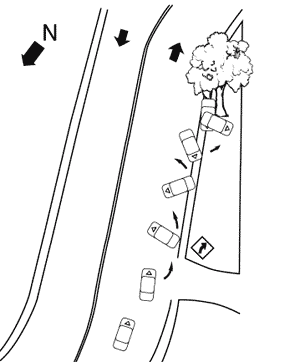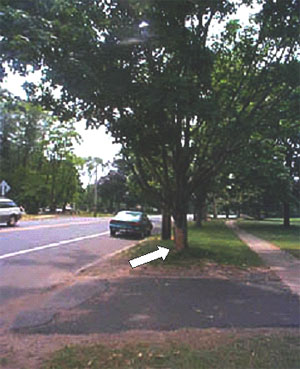|
|
|
|
|
|
17-Year-Old Pizza Delivery Driver Killed in a Motor Vehicle Accident
New Jersey FACE 02-NJ-021
January 10, 2003
On April 19, 2002, a 17-year-old pizza delivery driver was killed in a motor vehicle accident while on a delivery run. The victim was working his first night at a small independent pizzeria that was located in a suburban area. He was making his second delivery of the evening, driving to deliver a pizza to a private home about a mile from the pizzeria. It was raining heavily as he navigated a 30 mph "S" turn in the road. He lost control of his vehicle and spun out, striking a tree alongside the road. Police and EMS units arrived and transported him to the local hospital, where he died later that evening after undergoing surgery. NJ FACE investigators recommend following these safety guidelines to prevent future incidents:
INTRODUCTION
On April 22, 2002, a county Medical Examiner's office notified FACE staff of a 17-year-old youth who died in a motor vehicle accident while delivering a pizza. FACE investigators contacted the employer and received permission to conduct an investigation, which was done on May 28, 2002. At that time, FACE investigators interviewed the pizzeria owner and a resident of a home near the incident site. The incident site, tree, and traffic signs were photographed. FACE obtained additional information from the police, county prosecutor, and medical examiner's reports. Federal OSHA did not investigate this incident as motor vehicle accidents are out of their jurisdiction.
The employer was a small neighborhood pizzeria located in a suburban area. The owner had managed the pizzeria for four years before buying the business in March 2001. He was the third owner of the pizzeria, which had been in business for ten years. The pizzeria employed a total of eleven employees, ten part-time workers plus the owner who managed the shop full time. The victim was a 17-year-old high-school student who was at his first night of work as a pizza delivery person. He had applied for the job in response to a help-wanted sign on the shop door and was hired after a short interview. He was applying for his employment certificate (working papers) as required by New Jersey law and was to bring them in when he obtained them. The victim had previous experience as a bus boy in another pizzeria. He reportedly had his driver's license for only a few months prior to the incident.
INVESTIGATION
The incident occurred on Monday, April 19, 2002. The pizzeria was located in a suburban strip mall and serviced a small town and its neighboring homes. Located near the back of the mall, the restaurant did not attract a lot of foot traffic and did much of its business by delivering up to 100 orders per night. Exactly one week before the incident, the victim saw a help-wanted sign on the pizzeria door and filled out an application for the delivery job. The owner called him the following Wednesday and hired him after a short interview in which he explained that delivery drivers were paid an hourly wage plus any tips they collected from customers. The owner reported that the boy wanted the job in order to earn extra money to buy a car.
On Monday, the day of the incident, the victim arrived at 4:30 p.m. and was introduced to the staff. He was scheduled to work until 7:30 to 8:30 p.m., depending on the workload that night. Three other part-time delivery drivers were also working that day, all of whom used their own cars to make deliveries. The victim was using his father's car, a 1997 Mercedes Benz C230 four-door sedan. After the introductions, one of the experienced deliverers explained the job to him. He was to deliver within a four-mile radius of the pizzeria, an area he was familiar with since he lived nearby. A detailed map of the area was posted in the kitchen to assist the drivers. When phone orders were taken, it was company policy was to tell customers that it would take longer to deliver the order than was necessary. This gave the delivery drivers more time so they would not need to rush to make a delivery at a specific time. When not delivering, the drivers were to do other chores such as answering the phones, making pizza boxes, or filling the soda case.
It had been raining most of the day of the incident, and business was slow. The victim made one run, delivering three pizzas to three different addresses. At 6:20 p.m., the staff took a delivery order for a pizza. The victim went out to deliver the single pie to a private home located less than a mile away. It was a straightforward route down a well-traveled secondary road with a 40 mile-per-hour (MPH) posted speed limit, then onto a local road leading into a suburban neighborhood. It was still daylight as he drove down the secondary road, coming to an "S" turn with a curve advisory sign of 30 MPH. The police report states that a severe rainstorm with heavy winds was in progress at that time. Turning left to complete the second turn, he lost control of the car and spun off the road. He stuck a large tree broadside with the driver's side of his car (see diagram). A few residents heard the crash and called 911 at 6:50 p.m. Neighbors attempted to help the victim, finding him conscious and concerned about the condition of the car. He reportedly also left the vehicle to check on the damage. The first police officer arrived about five minutes after the accident was reported. His report states that he advised the victim to stay still, noting that he was disoriented and showed signs of possible internal injuries. The EMS arrived a few minutes later and removed the victim from the car. He was transported to a NJ Level II trauma center where he was admitted and taken to surgery for severe abdominal and head injuries. He died of his injuries at 11:30 p.m.
The police investigation reports indicate that the victim was not wearing a seat belt at the time of the incident. The police impounded and inspected the car, finding that the front tires were worn and in poor condition. Different air pressures (20-30 pounds per square inch) were also noted in each tire. There was no indication of alcohol or drug involvement.
 |
 |
Diagram 1 |
Photo 1 |
RECOMMENDATIONS/DISCUSSIONS
Recommendation #1: Minors under the age of 18 should not be permitted to drive a motor vehicle as per Federal child labor laws.
Discussion: Federal labor laws specifically prohibit minors in non-agricultural jobs from operating a motor vehicle as a regular part of their employment. This requirement is specified as Hazardous Order 2 (HO2) in the 17 Hazardous Occupation Orders for 16- and 17-year-old workers in the Federal Fair Labor Standards Act. Although the employer was legally exempt from the federal standard as his annual sales were less than $500,000, the NJ FACE Project strongly recommends that all employers follow the standards established to prevent youth injuries and fatalities. Further information may be found in the attached US Department of Labor publication, Child Labor Bulletin 101: Child Labor Requirements in Nonagricultural Occupations under the Fair Labor Standards Act. In addition, employers are responsible for following NJ State child labor standards. These laws cover minors less than 18 years of age, with additional regulations for workers less than 16 years of age. A brief summary of the New Jersey regulations are included in the appendix. Examples include:
This is only a partial listing of the regulations. Please consult the New Jersey Child Labor Laws and Regulations for a complete listing. This is available from the NJ Department of Labor, Division of Wage and Hour Compliance, PO Box 389, Trenton, NJ 08625-0389, telephone (609) 292-2337 or (609) 777-3200. The federal regulations are available from the US Department of Labor, Employment Standards Administration, Wage-Hour Division at (609) 989-2247.
Recommendation #2: Car owners should ensure that their vehicles are in proper operating condition.
Discussion: The police reported that the front tires on the victim's vehicle were in poor condition, which may have been a factor in losing control on the wet road. FACE investigators did not examine the vehicle or receive further information on the condition of the car. FACE does recommend that all vehicle owners maintain their vehicles in good operating condition before using them for work or other purposes.
Recommendation #3: Employers should become familiar with available resources on safety standards and safe work practices.
Discussion: It is extremely important that employers obtain accurate information on safety and applicable OSHA standards. The following sources of information may be helpful:
US Department of Labor, OSHA
Federal OSHA will provide information on safety and health standards on request. OSHA has several offices in New Jersey that cover the following counties:
Hunterdon, Middlesex, Somerset, Union, and Warren counties....................(732) 750-3270
Essex, Hudson, Morris, and Sussex counties................................................(973) 263-1003
Bergen and Passaic counties........................................................................(201) 288-1700
Atlantic, Burlington, Cape May, Camden, Cumberland, Gloucester,
Mercer, Monmouth, Ocean, and Salem counties..........................................(856) 757-5181
Federal OSHA Website: www.osha.gov
NJ Public Employees Occupational Safety and Health (PEOSH) Program
The PEOSH act covers all NJ state, county, and municipal employees. Two state departments administer the act; the NJ Department of Labor (NJDOL) which investigates safety hazards, and the NJ Department of Health and Senior Services (NJDHSS) which investigates health hazards. PEOSH has information that may also benefit private employers.
NJDOL, Office of Public Employees
Safety
Telephone: (609) 633-3896
Website: http://www.nj.gov/labor/lsse/lspeosh.html
NJDHSS, Public Employees Occupational Safety & Health Program
Telephone: (609) 984-1863
Website: www.state.nj.us/health/eoh/peoshweb
NJDOL Occupational Safety and Health On-Site Consultation Program
Located in the NJ Department of Labor, this program provides free advice to private businesses on improving safety and health in the workplace and complying with OSHA standards.
Telephone: (609) 292-3923
New Jersey State Safety Council
The NJ State Safety Council provides a variety of courses on work-related safety. There is a charge for the seminars.
Telephone: (908) 272-7712
Website: www.njsafety.org
Internet Resources
Other useful internet sites for occupational safety and health information:
www.cdc.gov/niosh/ - The CDC/NIOSH website.
www.dol.gov/elaws/ - USDOL Employment Laws Assistance for Workers and Small Businesses.
www.nsc.org - National Safety Council.
www.state.nj.us/health/eoh/survweb/face.htm - NJDHSS FACE reports.
www.cdc.gov/niosh/face/faceweb.html - CDC/NIOSH FACE website.
REFERENCES
Fatality Assessment and Control Evaluation (FACE) Project
Investigation # 02-NJ-021-01
Staff members of the New Jersey Department of Health and Senior Services, Occupational Health Service, perform FACE investigations when there is a report of a targeted work-related fatal injury. The goal of FACE is to prevent fatal work injuries by studying the work environment, the worker, the task and tools the worker was using, the energy exchange resulting in fatal injury, and the role of management in controlling how these factors interact. FACE investigators evaluate information from multiple sources that may include interviews of employers, workers, and other investigators; examination of the fatality site and related equipment; and review of records such as OSHA, police, and medical examiner reports, and employer safety procedures, and training plans. The FACE program does not seek to determine fault or place blame on companies or individual workers. Findings are summarized in narrative investigation reports that include recommendations for preventing similar events. All names and other identifiers are removed from FACE reports and other data to protect the confidentiality of those who participate in the program.
NIOSH funded state-based FACE Programs include: Alaska, California, Iowa, Kentucky, Massachusetts, Michigan, Minnesota, Nebraska, New Jersey, New York, Oklahoma, Oregon, Washington, West Virginia, and Wisconsin.
To contact New Jersey State FACE program personnel regarding State-based FACE reports, please use information listed on the Contact Sheet on the NIOSH FACE web site. Please contact In-house FACE program personnel regarding In-house FACE reports and to gain assistance when State-FACE program personnel cannot be reached.
|
|
NJ Department of Health & Senior Services |
|